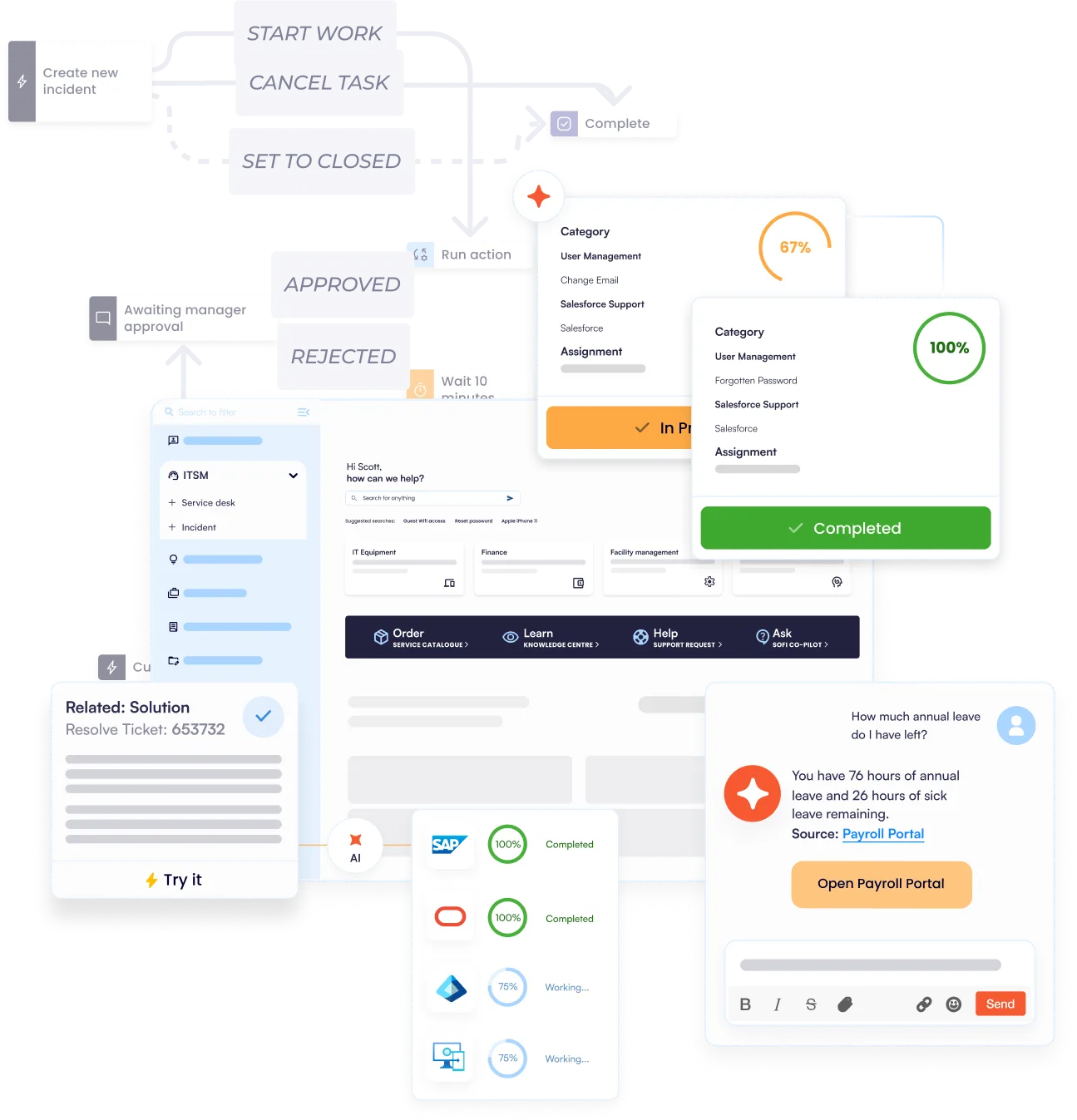What Is Enterprise Service Management (ESM)?
Enterprise service management (ESM) applies ITSM principles across other departments in the organization. It brings structured workflows, centralized request handling, and process automation to areas like HR, facilities, legal, finance, and operations.
Where ITSM focuses on technology services, ESM supports a wide range of internal services—onboarding requests in HR, maintenance tracking in facilities, or procurement approvals in finance. The idea is to improve service quality and responsiveness no matter where the request comes from.
Organizations use ESM to centralize service delivery into a single platform. This makes it easier to manage requests, analyze performance, and give employees a single centralized platform to go for help or information.
Key Differences Between ITSM and ESM

Main Features of an Effective ESM Platform
%201.svg)
Single System of Action and Record

Automation Across Departments

A Self-Service Catalogue

Integration with Frameworks Like ITIL, Agile, and DevOps

Cross-Department Workflow Management

Knowledge Management
Benefits of Enterprise Service Management
Improved Service Delivery


Better Visibility and Reporting
Reduced Platform Costs


Streamlined Governance and Compliance
Improved User Experience


Simplified Training and Onboarding
Getting Started with ESM
Assess Internal Needs
Start by identifying which departments would benefit from structured service management and which teams currently have structured service delivery. Document the types of requests each one handles, current bottlenecks, and key outcomes to track. Look at current technology stack and what tools teams are using to manage their service delivery.
Select an ESM Platform
Choose a platform that can support multi-department workflows, automation, and centralized reporting. Platforms like Servicely are designed to support enterprise-wide service delivery using AI-driven features and low-code setup options.
Configure Processes and Automation
Set up workflows that match each team’s existing processes. Build out service catalogs, approval chains, SLAs, and automation rules. Keep the configuration simple at first, then adjust based on user feedback and performance.
Integrate with Existing Systems
Make sure the ESM platform connects to tools you already use—such as HR software, asset management systems, or internal communication tools like Microsoft Teams. Integration prevents duplication, improves data accuracy, and creates a single system of action and record.
Train Internal Teams
Train both service teams and end users. Focus on how to submit requests, track progress, and access the knowledge base. Encourage feedback during onboarding to make improvements quickly.
Monitor and Improve
After launch, monitor performance metrics and collect feedback from users. Adjust workflows and automation to improve efficiency. Most platforms support continuous updates and flexible changes over time.

Choosing the Right ESM Platform
- Support for multiple departments without forcing them into IT-specific workflows
- Ability to create bespoke modules/applications to handle processes unique to your organization
- Centralized reporting that gives leadership complete visibility
- Automation and low-code configuration tools to reduce the IT burden
- Security and compliance features like role-based access and audit logs
- AI capabilities for intelligent ticket handling, suggestions, and routing, as well as advanced abilities, like AI-powered knowledge, virtual agents for self-service, and autonomous AI agents that carry out work proactively.
Sign up for Demo

FAQs
Yes. Platforms like Servicely support low-code customization, allowing teams to set up unique workflows, approvals, service catalogs, and automation.
ITSM refers to managing IT services specifically, while ESM applies those same service management practices across the business. ESM supports departments like HR, finance, and facilities using one consistent system.
Servicely has both ESM and ITSM capabilities out-of-the-box.
Look for unified service portals, automation, cross-department workflow tools, knowledge management, and integration with ITIL and Agile frameworks.
Security settings like role-based access, audit trails, and data encryption help organizations meet compliance standards while keeping data protected.
Most platforms offer user-friendly interfaces. Teams typically receive onboarding training, along with role-specific guides and access to help documentation.
Organizations track request resolution time, service volume, user satisfaction, and reduction in system costs to measure ROI. Additionally, use of automation and AI will lead to time savings and productivity gains which delivers substantial ROI.
AI and machine learning are changing how service requests are handled. Expect more predictive automation, better self-service tools, and increased integration with collaboration platforms.
Still have questions?
Start Building a Smarter Service Approach
If you're looking for a platform that helps connect your teams, automate service processes, and scale without complexity, Servicely provides the tools to get started.
Explore the platform or reach out to request a demo. The right ESM platform helps you deliver consistent service across your business with less effort and better results

.svg)



